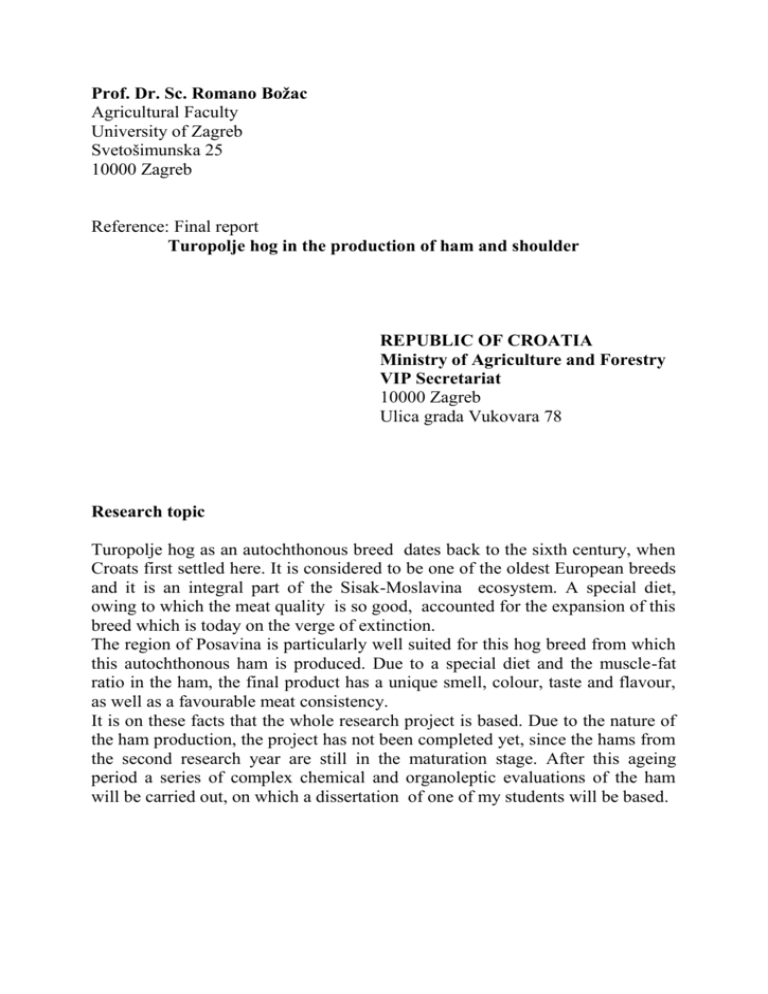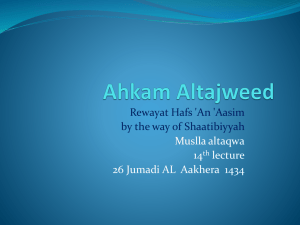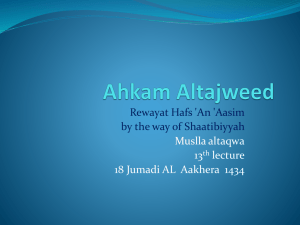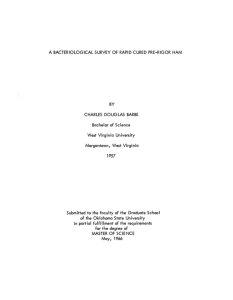Research topic
advertisement

Prof. Dr. Sc. Romano Božac Agricultural Faculty University of Zagreb Svetošimunska 25 10000 Zagreb Reference: Final report Turopolje hog in the production of ham and shoulder REPUBLIC OF CROATIA Ministry of Agriculture and Forestry VIP Secretariat 10000 Zagreb Ulica grada Vukovara 78 Research topic Turopolje hog as an autochthonous breed dates back to the sixth century, when Croats first settled here. It is considered to be one of the oldest European breeds and it is an integral part of the Sisak-Moslavina ecosystem. A special diet, owing to which the meat quality is so good, accounted for the expansion of this breed which is today on the verge of extinction. The region of Posavina is particularly well suited for this hog breed from which this autochthonous ham is produced. Due to a special diet and the muscle-fat ratio in the ham, the final product has a unique smell, colour, taste and flavour, as well as a favourable meat consistency. It is on these facts that the whole research project is based. Due to the nature of the ham production, the project has not been completed yet, since the hams from the second research year are still in the maturation stage. After this ageing period a series of complex chemical and organoleptic evaluations of the ham will be carried out, on which a dissertation of one of my students will be based. Technology The pigs used in the experiment were bred in their natural environment until they reached the weight of 120 kilos livestock. They were fed on acorns, roots, various truffles, worms etc. Then they were fattened in the national park «Lonjsko polje» up to the weight of 200 kilos. Their diet consisted of barley, soya beans and corn ad libitum. Then they were slaughtered, their hams and shoulders were processed, the concentration of pH1 and pH24 was measured as well as the drying and ageing shrinkage. This was done first after six then after 12 months. After the first research year the hams underwent thorough chemical analyses (aminoacids, fat acids, cholesterol, macro and microelements) and organoleptic evaluation. The hams were processed in the standard way. The legs were cut at the tarsal ankle, the hams were separated from the carcasses between the last lumbal and the first sacral vertebra. The pelvic bones (os ilium, os pubis and os ischii) and all the hanging parts were removed, and the ham was circularly trimmed at 10 centimeters above caput femoris. The hams were dry-pickled with 94,5% sea salt (70% bay-salt & 30% table salt), 2% garlic powder and 3,5 % ground black pepper and were left for 21 days to mature in the »Gavrilović» meat industry. During the 6 month ageing period, the hams and shoulders stayed in a chamber with the air flow of 10-20 cm/sec, 74% air humidity and the temperature between 13 and 14 degrees C, with no smoke. After the drying stage follows the 12 month ageing process in a chamber with light air circulation, the air humidity between 70 and 75% and the temperature between 12 and 15 degrees C. Economic study Hams can be produced in ham curing facilities housing 500, 1000, 5000 or more hams a year. It takes about 300,000 kunas to build a technologically acceptable ham curing facility. BUDGET EXPENDITURES .................................................................... KUNAS Meat, salt, spices for 1000 hams (20,000 kg of meat) ....... 760,000 Water, electricity, material costs .......................................... 50,000 Labour................................................................................. 100,000 TOTAL EXPENDITURES ................................................ 910,000 INCOME .................................................................................. KUNAS Hams (minus 40% dry loss) 12,000 kg x 150 kn = ....................... 1.800,000 Balance ............................................................................... 910,000 PROFIT .............................................................................. 890,000 APPLICABILITY Turopolje ham can be produced on the whole territory of the Sisak-Moslavina County. In the meat curing technology we must take into consideration the fact that the micro-climate (temperature, air flow and air humidity) must be artificially created. Since the meat of older pigs (200 kilos livestock) is more mature, the ham production must be based on such meat. However, since the artificially fattened pigs of this breed accumulate great quantities of fat, the profit is very questionable. Besides, meat industry and consumers are not inclined to such fatty meat. Therefore, it would be good to examine the quality of the ham produced from the hog bred in its natural environment. Naturally bred pigs are lean and their meat would be well suited for dry-cured meats of high quality. The hams got the highest grades for quality from the «Gavrilović» meat industry. Evaluation of farmers All the participants included in the project - the national park «Lonjsko polje», individual farms and the «Gavrilović» meat industry - were very satisfied with the project, especially «Gavrilović» that produced this smoked meat of highest quality. «Lonjsko polje» is specially interested in the project because of the preservation of the Turopolje breed, and the individual farmers will show their interest in the project by applying for the loans to build small ham smoking facilities on the territory of the Sisak-Moslavina County. With the help of the Ministry of Agriculture and Foresty the project has definitely proved viable. Quantitative data Over the 2 year research period a total of 20 pigs of Turopolje breed was bred and salted, i.e. 10+10+10 hams and shoulders were dry cured. In the second research year the shoulders were not salted, because they had an insignificant amount of muscle tissue, and, though of supreme quality, were not viable. In the second research year the hams were dry-cured with a pickle of different ingredients and were left to age for 12 months. Hams and shoulders were subjected to all the necessary chemical analyses and organoleptic evaluations. There was a graduation thesis based on the project, and the dissertation of Marina Krvavica, M.Sc., is also based on it. The hams were presented to the «Gavrilović» meat industry in Petrinja, where they got the highest marks. Turopolje ham was presented, evaluated and sampled on the meeting «Turopolje hog – an autochthonous Croatian breed», organized by «The Noble Turopolje Community», in 2002 in Velika Gorica. On that occasion the head researcher also presented the paper entitled «Turopolje hog in the function of ham and shoulder production». The research results are not complete yet, because 10 hams are still in the last stage of ageing. The research results are very extensive. The processed ham was weighed, the content of pH1and pH24 ions measured, the cooling, salting and drying loss determined and the basic chemical analyses (free aminoacids, free fat acids, macro and micro elements,cholesterol) and organoleptic evaluations were carried out. Qualitative data In the project «Turopolje hog in the production of ham and shoulder», the hams and shoulders were salted in the first research year. Having studied the results, in the second year only the hams were salted, because the shoulders with no subcutaneous fatty tissue do not look appealing enough for marketing purposes. The hams looked good and got the highest organoleptic evaluation. Due to the special diet and favourable muscle-fat ratio in the ham, the final product has a unique and superior smell, colour, taste and flavour, as well as the meat consistency. Conclusions 1. In my opinion, the project «Turopolje hog in the production of ham and shoulders» has accounted for all the expenses and met all the expectations regarding this research project. 2. The research project is a great contribution to the science and practice, because so far there have been no researches of the Turopolje hog of this extent and complexity. 3. Both a graduation thesis and a dissertation are based on the results of this research project. 4. The market is offered an autochthonous dry cured meat product of supreme quality, with no toxic substances (nitrates, nitrites), polycyclic aromatic compounds and other carcinogens and mutagens from the smoke. 5. I would like to express my thanks to the Ministry of Agriculture and Forestry, «Lonjsko Polje», «Gavrilović», individual family husbandries and all the associates who took part in the project. 7th November 2003 Head researcher Prof. Dr. Sc. Romano Božac








